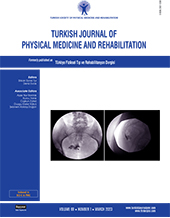Comparative effects of radial and focused extracorporeal shock wave therapies in coccydynia
2 Department of Biostatistics, Yüzüncü Yıl University School of Medicine, Van, Türkiye DOI : 10.5606/tftrd.2023.10371 Objectives: This study was conducted to compare the effects of radial and focused extracorporeal shock wave therapy (ESWT) in patients with coccydynia.
Patients and methods: In this prospective randomized double-blind study conducted between March 2021 and October 2021, 60 patients with coccydynia (50 males, 10 females; mean age: 35.9±12.0 years, range 18 to 65 years) were randomized into three groups (n=20) according to different wave types of ESWT: focused, radial, and sham. The Visual Analog Scale (VAS) was used for pain assessment, and the Oswestry Disability Index (ODI) was used for functional assessment in all patients before the treatment (baseline), after the completion of four sessions of treatment (fourth week), one month after the end of the treatment (eighth week), and three months after the end of the treatment (16th week).
Results: The mean body mass index of the participants was 26.2±3.0. Compared to baseline, the VAS scores at four weeks were reduced only in the radial ESWT group (p<0.05). Compared to baseline, the VAS and ODI scores at eight and 16 weeks were significantly reduced in both the focused and radial ESWT groups (p<0.05 for all). The radial ESWT group was significantly superior to the focused ESWT group in the comparisons between the groups at four weeks in the VAS values and at 16 weeks in the ODI scores (p<0.05 for all).
Conclusion: Radial and focused ESWT are both effective in treating coccydynia compared to sham ESWT. However, radial ESWT may be more effective in the treatment of coccydynia.
Keywords : Coccydynia, focused ESWT, radial ESWT

















